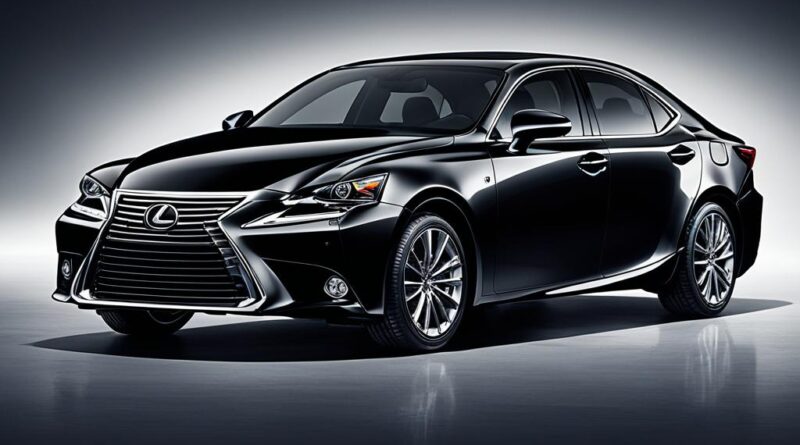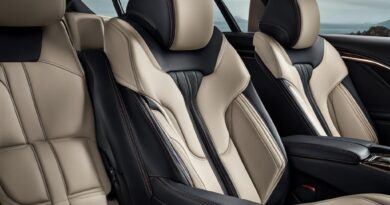Lexus IS vs ES: Luxury Sedan Comparison Guide
When it comes to luxury sedans, both the Lexus IS and Lexus ES models have established themselves as reputable contenders in the market. While the Lexus IS leaves a sporty impression, the ES chooses a more refined approach, catering to different preferences. In this comprehensive review, we will discuss the difference between Lexus IS and ES, delving into their performance and interior offerings in addition to comparing essential features and different trim levels.
Key Takeaways
- The Lexus IS focuses on sportiness and agility, while the ES prioritizes comfort and luxury.
- Both sedans seat up to five passengers, but the ES offers a larger rear seating area and greater cargo capacity.
- The IS has a higher engine output potential, ranging from 241 to 472 horsepower, whereas the ES comes standard with a 302 horsepower engine.
- Interior features, like dual-zone automatic climate control and power-adjustable front seats come standard in both models, with slight variations in terms of multimedia systems.
- Pricing for both the Lexus IS and ES starts just over $40,000, but evaluating fuel efficiency, interior space, and overall value can help determine the best option for individual needs.
Understanding the Distinction: Lexus IS vs ES
When considering which Lexus model is better, one must examine the key distinctions between the Lexus IS and ES sedans. These differences can be found primarily in dimensions, engine power, and acceleration capabilities. The IS offers a sportier profile with higher engine output potential, while the ES is more conservative with a slightly slower 0-60 acceleration but greater cargo space and a more extensive trim selection, including hybrid models.
Additionally, the IS boasts more front legroom whereas the ES has superior rear headroom and legroom. Shoppers at a Lexus dealership can expect a hands-on Lexus IS vs Lexus ES comparison of these nuances.
| Aspect | Lexus IS | Lexus ES |
|---|---|---|
| Dimensions | Compact size | Larger size |
| Engine Power | Higher engine output potential | More modest engine output |
| Acceleration | Faster 0-60 | Slower 0-60 |
| Cargo Space | Smaller cargo capacity | Larger cargo capacity |
| Trim Selection | Less extensive trim selection | More extensive trim selection, including hybrid models |
| Front Legroom | More front legroom | Less front legroom |
| Rear Headroom and Legroom | Less rear headroom and legroom | More rear headroom and legroom |
By understanding these key differences, shoppers can make a more informed decision when choosing between the Lexus IS and ES.
Lexus IS vs ES: A Detailed Performance Breakdown
When comparing the Lexus IS and ES, their respective performance capabilities are worth examining. Both models boast reliable engineering, but they cater to unique driving preferences. The IS offers a more powerful engine lineup and sporty handling, while the ES brings consistent performance and efficiency to the table.
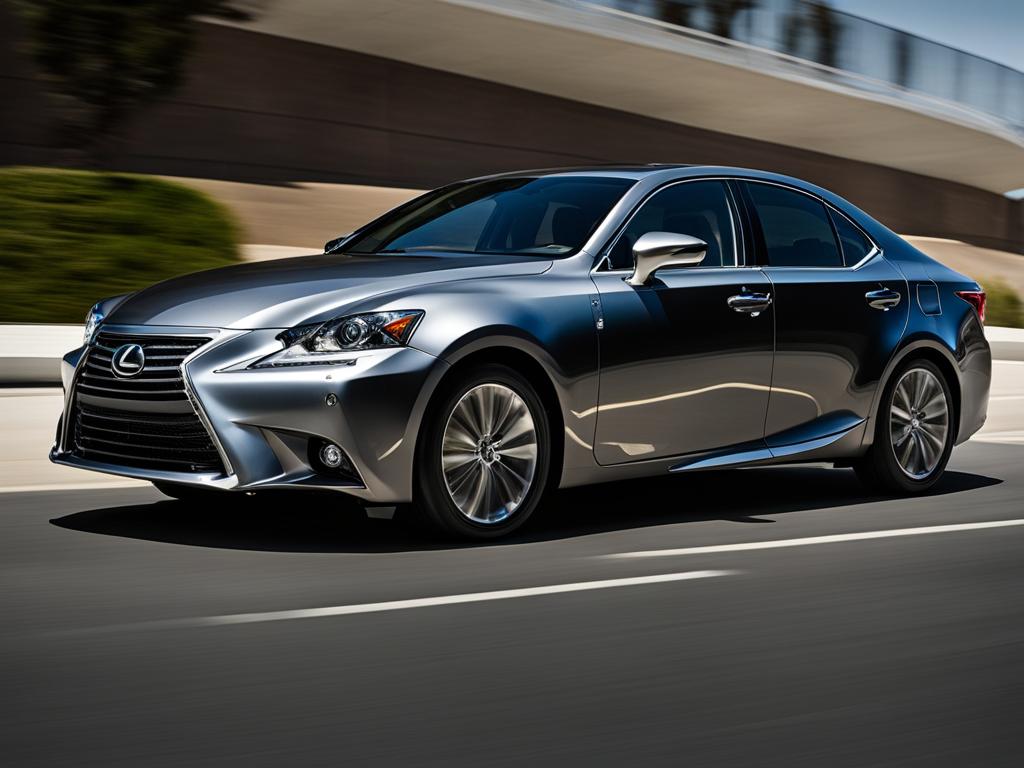
Power and Agility Differences
The Lexus IS features a wider range of engines, starting from a turbocharged 2.0-liter 4-cylinder and going up to a robust 5.0-liter V-8 capable of 472 horsepower. This sport-focused model provides drivers with agile and responsive handling. The Lexus ES, on the other hand, maintains a 3.5-liter V-6 engine across its trims, offering a consistent 302 horsepower output.
Engine Specifications: From Efficiency to Powerhouses
The ES lineup includes hybrid versions such as the ES 300h, pairing a 2.5-liter 4-cylinder engine with an electric motor for increased efficiency. The IS does not offer any hybrid options, but its F SPORT trims enhance performance to cater to enthusiasts who crave sportier dynamics on the road.
Main Engine Options:
| Model | Engine | Horsepower | Torque |
|---|---|---|---|
| Lexus IS | 2.0-liter Turbo 4-Cylinder | 241 | 258 lb-ft |
| Lexus IS | 3.5-liter V-6 | 311 | 280 lb-ft |
| Lexus IS | 5.0-liter V-8 | 472 | 395 lb-ft |
| Lexus ES | 3.5-liter V-6 | 302 | 267 lb-ft |
| Lexus ES | 2.5-liter 4-Cylinder + Electric Motor (Hybrid) | 215 (combined) | 163 lb-ft (gas engine only) |
Accelerating Head to Head: 0-60 Comparisons
Comparing the acceleration capabilities of the Lexus IS and ES highlights the IS’s emphasis on performance. The IS 500 F SPORT Performance trim reaches 0-60 mph in a swift 4.4 seconds, outpacing the ES 350, which takes about 6.6 seconds. This distinction reveals the IS’s sportier pedigree and caters to drivers who seek exhilarating driving experiences.
In the realm of reliability, both the Lexus IS and ES deliver dependable, refined rides, underscoring Lexus’ commitment to crafting exceptional luxury sedans. Ultimately, the choice between the Lexus IS and ES comes down to personal preferences and driving priorities, be it power and agility, or consistent performance and efficiency.
Craftsmanship and Comfort: Interior Amenities
In any Lexus ES review, you’ll find that both the IS and ES models feature luxurious cabins with premium comfort, displaying Lexus’s dedication to quality and sophistication. While there are shared amenities between the two models, each offers distinct features that cater to different preferences.
The Lexus ES boasts a dual-zone automatic climate control system, which allows occupants to optimize their environment for comfort. In addition, the ES comes with 10-way power-adjustable front seats that enable drivers and passengers to fine-tune their seating positions for long drives. On the other hand, the Lexus IS offers a similar luxurious cabin experience with 8-way power-adjustable front seats.
When it comes to infotainment, both sedans support modern smartphone integrations, making it easy for drivers to stay connected while on the go. The IS features an 8.0-inch Lexus Multimedia System, while the ES comes with an equally impressive 8.0-inch Lexus Interface touchscreen.
Expansive legroom and high-quality materials combine to provide a truly comfortable and visually appealing environment in both the Lexus ES and IS models.
In order to provide a clear breakdown of the shared features and unique offerings of the Lexus ES and IS interiors, take a look at the table below:
| Features | Lexus ES | Lexus IS |
|---|---|---|
| Dual-zone automatic climate control | Yes | Yes |
| Power-adjustable front seats | 10-way | 8-way |
| Infotainment System | 8.0-inch Lexus Interface touchscreen | 8.0-inch Lexus Multimedia System |
| Apple CarPlay® and Android Auto™ compatibility | Yes | Yes |
Ultimately, both the Lexus IS and ES models offer a luxurious cabin experience that caters to a wide range of preferences and driving scenarios. Choosing between the two will depend on prioritizing either a performance-centric or comfort-focused driving experience.
Choosing the Right Luxury Sedan: Trims and Upgrades
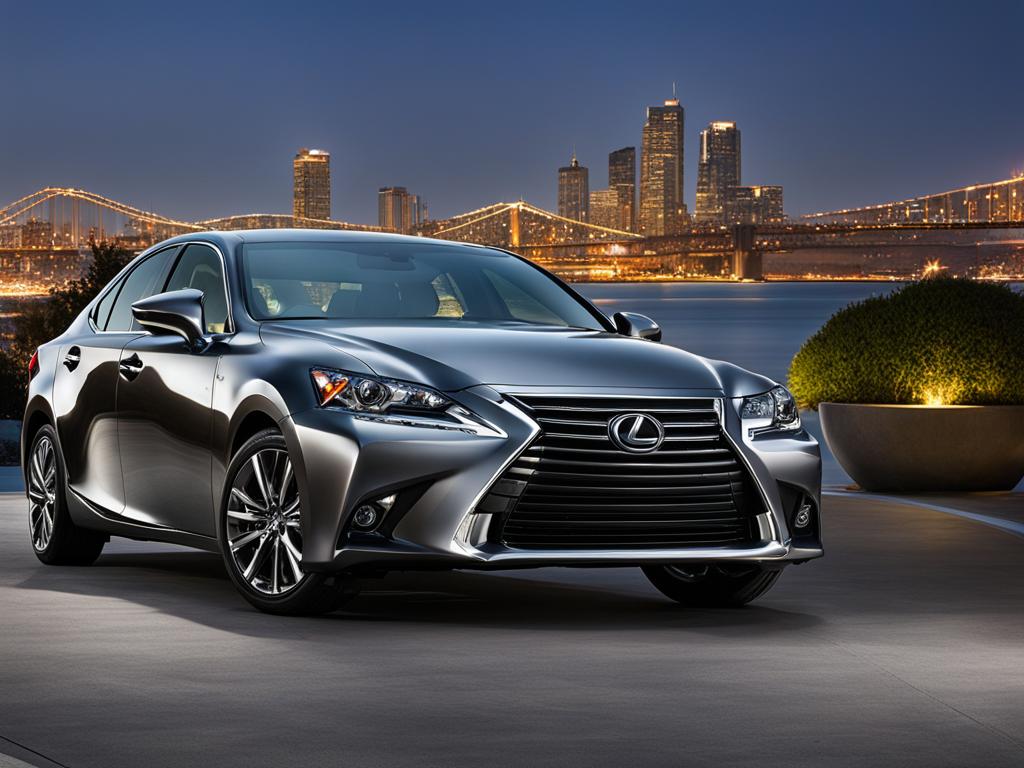
When comparing the Lexus IS vs ES trim lineup, both sedans offer versatility with distinct features catering to different preferences. The Lexus ES has a diverse selection of trims ranging from the ES 250 AWD to the premium ES 350 F SPORT Handling, including hybrid versions for those seeking efficiency.
In contrast, the Lexus IS trims focus more on performance with fewer options. However, these trims compensate with offerings such as the highly-regarded IS 500 F SPORT Performance, boasting exclusive enhancements and impressive driving dynamics.
To guide potential buyers, here is a brief overview of some notable trims for both Lexus IS and ES lines:
- Lexus IS 300: Base model with a 241-horsepower engine and an 8-speed automatic transmission.
- Lexus IS 350 F SPORT: A sportier option featuring a 311-horsepower engine and adaptive suspension.
- Lexus IS 500 F SPORT Performance: Top trim with a powerful 472-horsepower V8 engine and advanced performance features.
- Lexus ES 250 AWD: Entry-level trim with a 203-horsepower engine, AWD, and comprehensive safety features.
- Lexus ES 350: Mid-level trim with upgraded performance, featuring a 302-horsepower V6 engine.
- Lexus ES 350 F SPORT Handling: Premium sporty trim with exclusive styling, suspension, and interior upgrades.
- Lexus ES 300h: The hybrid variant with a 2.5-liter 4-cylinder engine and an electric motor, providing a total of 215 horsepower and exceptional fuel efficiency.
Ultimately, when deciding between the Lexus IS trims and Lexus ES trims, prospective buyers should consider their priorities in terms of luxury, performance, and technology, as well as how each model’s attributes align with their individual needs and preferences.
Lexus Sedan Similitudes: Shared Features and Tech
While the Lexus IS and ES have distinctive charms, they also share some features and technologies that advocate the brand’s dedication to luxury and convenience. In this section, we delve into the infotainment systems and connectivity options that are standard across both models, as well as the luxurious nuances both sedans offer.
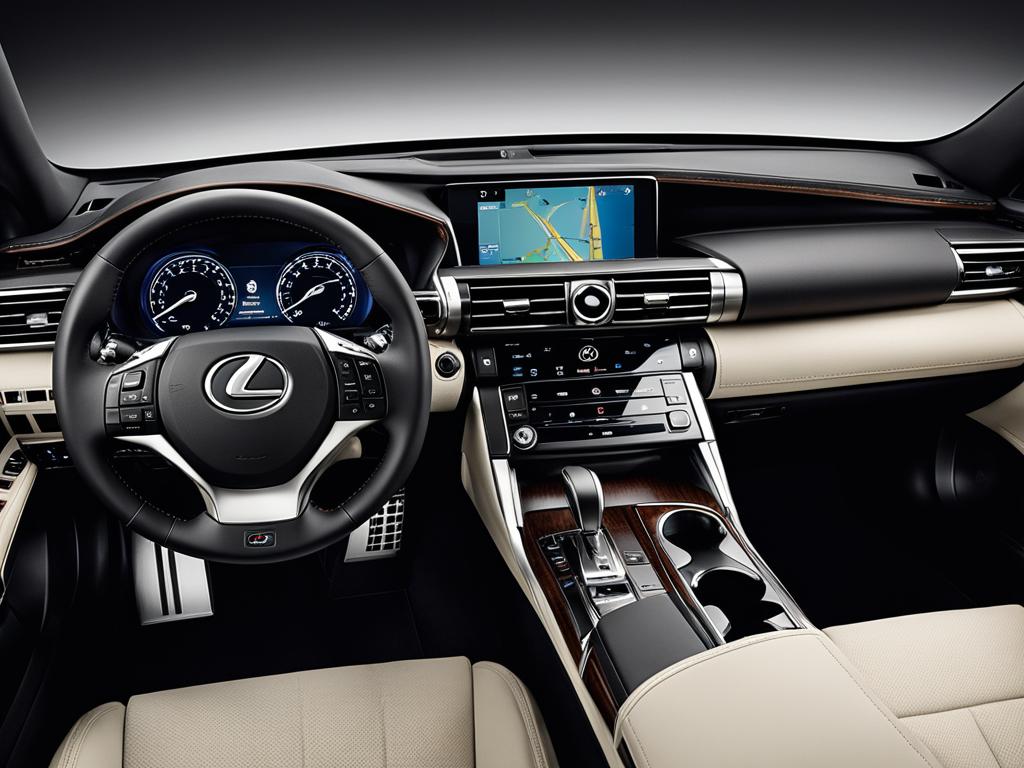
Infotainment Systems and Connectivity
A testament to Lexus’ commitment to staying at the forefront of technology, both the IS and ES sedans come equipped with staple infotainment options. These include Apple CarPlay® and Android Auto™ compatibility, allowing for seamless smartphone integration and a more connected driving experience. Moreover, both models encompass an 8.0-inch screen as standard, with the option to upgrade to larger displays for those seeking more screen real estate.
Luxurious Staples Across the Board
Irrespective of the Lexus IS vs ES price comparison, both sedans demonstrate the brand’s expertise in crafting high-quality and luxurious interiors. Regardless of the model chosen, drivers can anticipate premium materials and refined design sensibilities. This shared elegance exemplifies Lexus’ reputation for delivering luxurious and stylish driving experiences in every vehicle they manufacture.
Which Lexus Model is Better in Which Scenarios?
In this section, we will analyze the difference between Lexus IS and ES in terms of suitability for various driving environments, specifically focusing on urban driving and open road performance.

Comparing Urban Maneuverability and Comfort
The Lexus IS excels in maneuverability and comfort in urban settings, thanks to its more compact dimensions and sporty handling. Its smaller size and responsive steering allow it to easily navigate tight city streets and cramped parking lots, making it an ideal choice for drivers who frequently travel in bustling metropolitan areas.
Performance and Efficiency on Open Roads
On the other hand, the Lexus ES shines during long-distance cruising, where its spacious interior and fuel efficiency offer unmatched comfort and cost-effectiveness. The ES’s generous trunk and rear-seat space facilitate family vacations or business trips with ease, allowing passengers to travel in luxury while minimizing fuel costs. Thus, drivers who often embark on lengthy journeys and prioritize cabin space and fuel economy should consider the Lexus ES for their needs.
In conclusion, the ideal Lexus model depends on the user’s specific driving habits and demands. For city dwellers, the Lexus IS’s urban-friendly size and agility provide unparalleled convenience. Conversely, the Lexus ES is the top pick for drivers who value interior space and fuel efficiency on open roads.
Lexus IS vs ES: Price and Value Considerations
While the Lexus IS and ES have similar starting prices, hovering just above $40,000, it is important to consider each model’s strengths and overall value by comparing them in terms of fuel economy, interior space, and resale value. The Lexus IS stands out for its sporty performance, while the ES boasts better fuel economy and a more spacious cabin. Let’s take a closer look at the key factors that contribute to each model’s value proposition when evaluating these luxury sedans as potential investments.

| Factors | Lexus IS | Lexus ES |
|---|---|---|
| Starting Price | $40,075 | $40,925 |
| Fuel Economy (city/highway/combined) | 21/31/25 mpg | 22/32/26 mpg |
| Interior Space | Compact | Spacious |
| Resale Value | Good | Excellent |
In terms of resale value, the Lexus ES has a slight advantage over the IS, with its lower depreciation rate and strong demand in the used car market. The Lexus ES also outperforms the IS when it comes to interior design, often making it the better choice for those prioritizing comfort and cost of operation over sporty dynamics.
Ultimately, the decision between the Lexus IS and ES comes down to one’s personal preferences and needs. If a compact and sporty luxury sedan is what you’re after, the IS might be the right fit for you. However, if you value a spacious and comfortable interior paired with better fuel efficiency and resale value, the ES could be the better investment.
Conclusion
In the Lexus IS vs ES comparison, both luxury sedans showcase the brand’s commitment to quality, technology, and performance. Choosing the best luxury sedan ultimately depends on your personal preferences and driving needs. The Lexus IS offers a sportier driving experience with its compact dimensions and agile handling, making it a popular choice for those with a spirited driving attitude and urban lifestyle.
On the other hand, the Lexus ES caters to passengers seeking a more spacious and comfortable ride. With its larger interior, smooth performance, and fuel-efficient options, it proves to be an excellent choice for long-distance cruising, family transportation, or professional use.
Regardless of your choice, both the Lexus IS and ES models fulfill the promise of a luxurious driving experience and uphold the brand’s reputation for reliability. As you weigh your options, consider how each sedan aligns with your driving preferences and lifestyle, and rest assured that you’re investing in a top-quality vehicle.
FAQ
How do the dimensions of Lexus IS and ES differ?
Both sedans have seating for up to five passengers, but the Lexus ES offers a more spacious rear seating area and a larger 13.9 cubic feet cargo capacity compared to the more compact Lexus IS and its 10.8 cubic feet of cargo space.
What are the performance differences between Lexus IS and ES?
The Lexus IS has more engine options ranging from 241 to 472 horsepower, while the Lexus ES comes with a standard 302 horsepower engine. The IS is designed for quick acceleration, while the ES focuses on fuel efficiency and a smooth ride.
How do the interiors of Lexus IS and ES compare?
The Lexus ES comes with dual-zone automatic climate control, 10-way power-adjustable front seats, and a 10-speaker audio system, while the Lexus IS includes dual-zone climate control with 8-way power-adjustable front seats and an 8.0-inch Lexus Multimedia System.
Which Lexus sedan is better suited for city driving?
The IS’s more compact dimensions and sporty handling make it better suited for city driving due to its maneuverability and responsive steering.
Which Lexus sedan is better for long-distance cruising?
The ES’s spacious interior and fuel efficiency make it an ideal choice for long-distance cruising, providing comfort and cost-effectiveness on open roads. Its larger trunk and rear-seat space also offer practical advantages for family or business needs.
How do the Lexus IS and ES compare in terms of price?
Both the Lexus IS and ES start within a similar price range, just over ,000. However, the ES generally offers better fuel economy and interior space, making it the better choice for those prioritizing comfort and cost of operation over sporty dynamics.

